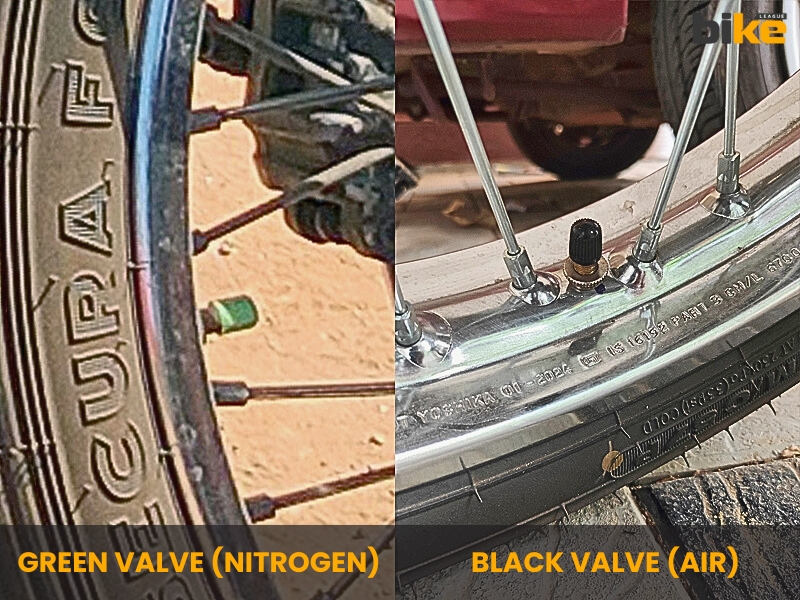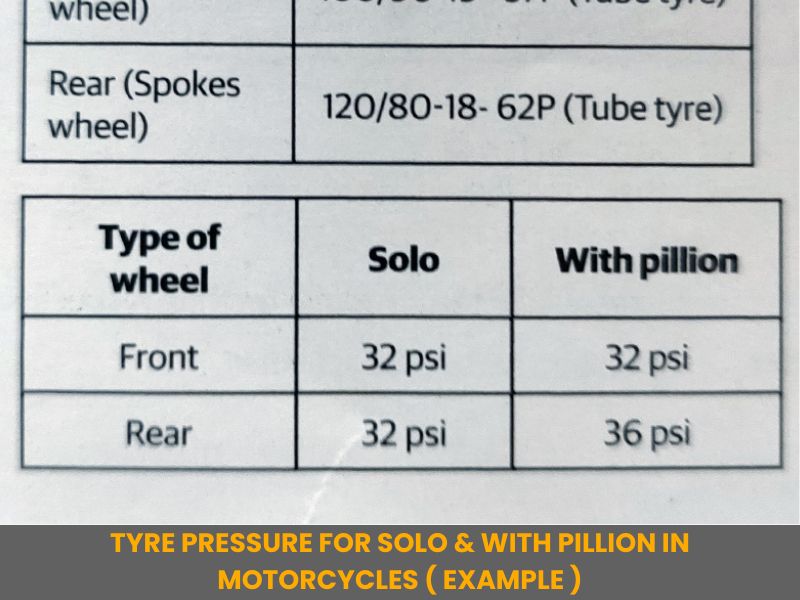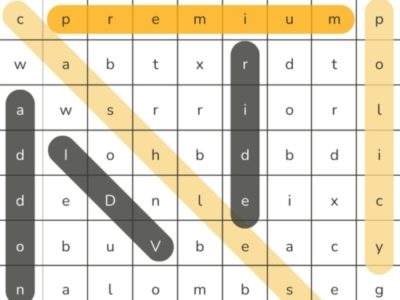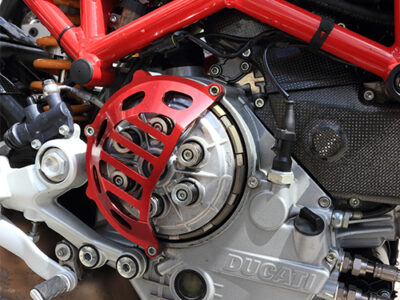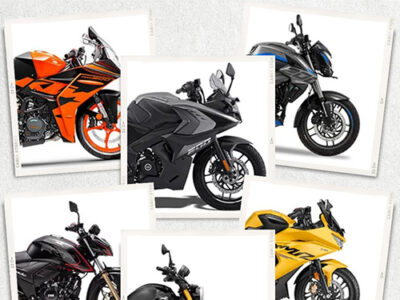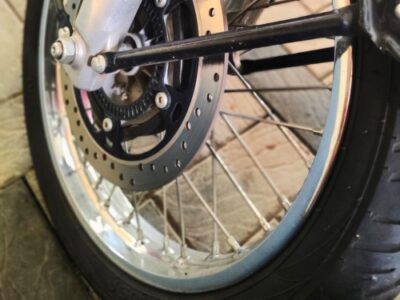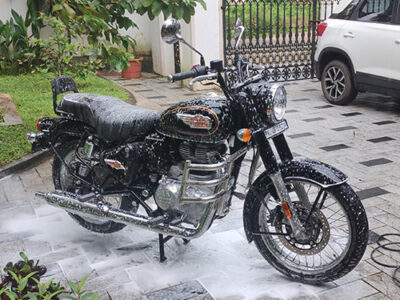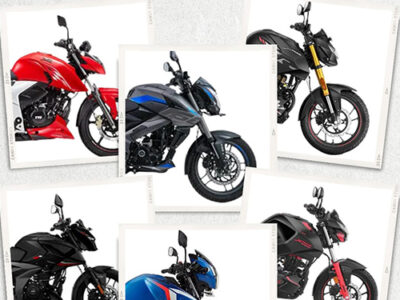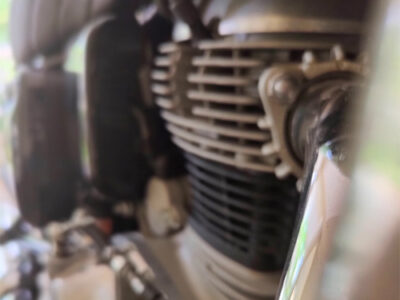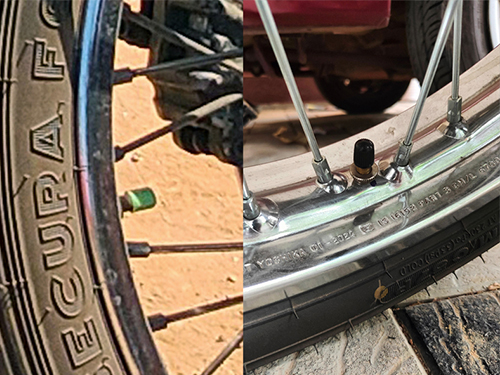
Long story short – Get all doubts about nitrogen vs air filling in bike tyres, tyre pressure & tyre loss in India right here, and we will explain in the simplest terms.
Bike owners have many doubts, myths, and misconceptions regarding nitrogen vs air filling in tyres, and we are here to clear all doubts. While in a tube and tubeless tyres, there are certain things we need to be aware of and note. It’s time to decipher all the myths, doubts, and misconceptions right here in this article.
What is nitrogen filling in a bike?
Nitrogen filling involves inflating tyres with nitrogen gas instead of regular air. Regular air is composed of approximately 78% nitrogen, 21% oxygen, and 1% other gases. When tyres are filled with nitrogen, the nitrogen concentration is increased to about 93-95%.
What is air filling in a bike?
Air filling in bike tyres refers to inflating the tyres with air, primarily composed of nitrogen (about 78%), oxygen (about 21%), and trace gases. Proper inflation is crucial for motorcycle tyre performance, safety, and longevity.
Difference between nitrogen vs air filling in bike tyres
1. Molecular Size and Pressure Retention
Nitrogen molecules are larger than oxygen molecules, which results in slower pressure loss and longer retention in bike tyres. Nitrogen-filled tyres maintain their pressure for a longer period than those filled with regular air filled bike tyres. This characteristic can reduce the frequency of pressure checks and adjustments, providing a more consistent riding experience.
2. Temperature Stability and Moisture Content
Nitrogen is an inert gas, meaning it does not react with other substances or corrode the inside of bike tyres. It also lacks the moisture and corrosive elements in regular air, which can lead to oxidation of the inner tyre components.
Nitrogen-filled bike tyres run cooler, reducing the risk of overheating and tyre failure. This safety feature helps maintain consistent handling and grip, providing riders with security and confidence on the road.
3. Cost and Availability
One significant drawback of nitrogen in tyres is the cost. Nitrogen filling is generally more expensive than regular air, often available for free or at a minimal charge at most fuel stations and tyre shops. Additionally, finding a nitrogen filling station can be challenging, especially in remote or less urbanized areas, adding to the cost and inconvenience.
4. Performance and Practicality
While nitrogen offers benefits such as better pressure retention and reduced moisture content, it’s important to note that the performance improvements for regular motorcycle riders are often minimal. This information equips riders with a comprehensive understanding of the topic, making them feel more informed and knowledgeable.
Regular air already contains 78% nitrogen, and the additional benefits of using pure nitrogen may not justify the higher cost and inconvenience for everyday use. For most riders, using regular air is more practical and cost-effective, providing a sense of reassurance and comfort in its simplicity and ease of access.
Advantages of filling nitrogen in tubeless motorcycle tyres
- Slower bike tyre pressure loss: Nitrogen molecules, larger than oxygen molecules, resulting in slower pressure loss through the tyre liner. This helps maintain consistent pressure for extended periods, especially for drivers who don’t frequently check their tyre pressure or face fluctuating temperatures.
- Reduced tyre oxidation: Reduced oxidation occurs with nitrogen inflation as nitrogen lacks moisture in regular air. This helps prevent the tyre’s internal corrosion, potentially extending your tyre’s lifespan.
- Improved mileage: results from consistent tyre pressure achieved through nitrogen inflation. Properly inflated tyres experience less rolling resistance, leading to slightly better fuel economy.
- Enhanced safety: Additionally, enhanced safety is achievable as consistent pressure improves handling and traction, contributing to overall vehicle safety.
Disadvantages of filling nitrogen in tubeless motorcycle tyres
- Expensive: Nitrogen inflation is usually more costly than filling your tyres with regular air.
- Availability: It’s important to note that not all gas stations provide nitrogen inflation services. If you choose to top up your tyres with regular air, the advantages of nitrogen inflation will diminish.
- Top-up challenges: Ideally, removing the air from the tyre and refilling it with nitrogen is recommended.
Issue with under inflated motorcycle tyres
- Decreased Handling and Stability: Soft, underinflated tyres flex more, leading to a vague and unpredictable feel while riding, especially when taking corners. This can significantly heighten the chances of accidents.
- Increased Tyre Wear: Excessive flexing causes uneven wear on the tyre tread, particularly on the edges. This shortens the lifespan of your tyres and necessitates more frequent replacements.
- Blowouts: In severe cases, a significantly underinflated tyre can overheat and result in a blowout, leading to a sudden loss of bike tyre pressure and, potentially, loss of control.
- Higher Fuel Consumption: Underinflated tyres create more rolling resistance, making the engine work harder and reducing fuel efficiency.
Issue with overinflated motorcycle tyres
- Reduced Traction: An overly firm tyre has less contact with the road surface, reducing grip and traction, especially during braking and cornering. This can be particularly concerning in wet conditions.
- Harsh Ride: An overinflated tyre provides a stiffer ride, transmitting more bumps and vibrations to the rider, resulting in a less comfortable journey.
- Center Tread Wear: Overinflated tyres wear unevenly, with the centre tread bearing the brunt of the wear. This decreases the overall lifespan of the tyre.
FAQ related to nitrogen vs air filling in bike tyres
1. Is there a benefit to adding nitrogen to tube tyres in motorcycles?
No. The reason behind this is that nitrogen is filled inside the tube within the tyre and hence does not protect the outer walls of the tyre from heat and undulations. So, the tyres have no benefit; therefore, it is better to fill tube tyres with air instead of nitrogen.
2. Does regular air or compressed air contain nitrogen?
Yes. Regular air is about 78% nitrogen, 21% oxygen, and 1% other gases. Compressed air is normal air forced into a smaller space, increasing pressure.
3. What is the time gap for air pressure checking in motorcycles?
The time gap to check the pressure for air-filled tyres is between 1-2 weeks.
4. What is the time gap for nitrogen pressure checking in motorcycles?
The time gap to check the pressure for nitrogen-filled tyres is 4-5 weeks.
5. Do petrol pumps in India offer nitrogen filling in motorcycles?
No, In India, petrol pumps primarily offer compressed air for tyre filling, not nitrogen.
6. How do you know if a motorcycle tyre is filled with nitrogen or air?
The valve cap is the primary way to tell whether a motorcycle tyre is filled with nitrogen or air. If it’s green, nitrogen is definitely present. If it’s black, it will mostly be air-filled. Check the picture given below.
7. How to check for motorcycle tyre pressure at home?
There are devices specifically for analogue and digital devices to check tyre pressure at home.
Check out this link for more details.
8. What is the recommended tyre pressure for both front and rear tyres in motorcycles?
Check the owner’s manual for specific details on the exact tyre pressure for the front and rear tyres.
9. Should we increase tyre pressure if there is a pillion in both motorcycle tyres?
It is usually given in the owner’s manual, like the picture below. Tyre pressure should be higher on the rear wheel, while on the front wheel, it’s almost the same in case a pillion is present. Check the picture given below.
10. Which is more expensive, nitrogen or air filling in motorcycles?
Nitrogen is definitely the most expensive fuel. Air filling is entirely free in petrol pumps, while in other shops, it will be around Rs 10-20 per bike tyre (approx); nitrogen comes in between Rs 30-40 per tyre (approx).
11. Does nitrogen fill significantly improve fuel efficiency?
Nitrogen inflation usually improves fuel efficiency minimally compared to the benefits of maintaining proper bike tyre pressure with regular air.
12. Why is compressed air considered harmful to tyres?
Compressed air contains oxygen, which can destroy rubber and other tyre materials due to oxidation, leading to deterioration over time.
13. Can I mix air with nitrogen in my tyres?
While it’s possible to add air to nitrogen-filled tyres, it reduces the nitrogen concentration. It’s better to maintain correct inflation with air than to have under-inflated tyres with nitrogen.
14. Does nitrogen improve fuel economy and tyre life?
Properly inflated tyres, whether with nitrogen or air, can improve fuel economy and extend tyre life. Nitrogen may offer slight advantages in maintaining consistent pressure.
15. Are nitrogen filling stations widely available?
Nitrogen filling stations are less common than air compressors, which can be a limitation during long trips.
16. Does nitrogen prevent tyre corrosion?
Nitrogen lacks moisture and contaminants, reducing the risk of corrosion compared to air, which contains water vapour.
17. Is nitrogen suitable for all types of tyres?
Nitrogen is ideal for all tyres and vehicles, providing benefits like consistent pressure and reduced moisture.
18. Does nitrogen affect tyre temperature stability?
Nitrogen helps maintain stable tyre pressure and temperature, which is beneficial for consistent handling.
19. What is the nitrogen purity level in tyres?
When nitrogen is filled into tyres, the concentration typically reaches 93% – 95%.
Common myths about nitrogen vs air filling in bike tyres
Myth 1: Nitrogen does not leak from tyres as quickly as air.
Fact: Both nitrogen and air will leak over time, but nitrogen leaks at a slower rate due to larger molecules.
Myth 2: Nitrogen is unaffected by temperature changes.
Fact: Nitrogen-filled tyres maintain pressure better in fluctuating temperatures but are not immune to temperature-related changes.
Myth 3: Nitrogen-filled tyres are maintenance-free.
Fact: Regular pressure checks are necessary for nitrogen-filled tyres to identify leaks and ensure safety.
Myth 4: Nitrogen completely prevents tyre and wheel corrosion.
Fact: While nitrogen reduces moisture, most air systems already limit water vapour, making corrosion from air not a widespread issue.
Myth 5: Nitrogen significantly improves ride quality.
Fact: Little evidence supports claims of improved ride quality with nitrogen.
Myth 6: Nitrogen saves significant fuel costs.
Fact: The fuel savings from using nitrogen are minimal and often not noticeable.
Myth 7: Nitrogen is a new technology.
Fact: Nitrogen has been used in various applications, including aviation and racing, for many years.
Myth 8: Nitrogen is non-reactive and completely safe.
Fact: Nitrogen is inert and stable, making it safe for tyre use.
Myth 9: Nitrogen is not worth the cost for average riders.
Fact: For most riders, the benefits of nitrogen do not outweigh the price, especially when air is free and readily available.
Other related articles from Bikeleague India
- Best bike tyre brands for your motorcycle in India
- Types of Two wheeler tyres explained
- How to read two wheeler tyre code and tyre size
- What is Motorcycle ABS? – Doubts, Queries and FAQ
- Top 10 proven tips to increase two wheeler mileage/
Conclusion
If you have any other questions or queries, email us at bikeleague2017@gmail.com. You can also share your doubts or opinions in the comments section below. We are always eager to help and assist you. Also, here are several social media platforms of Bikeleague India to raise your suspicions.

